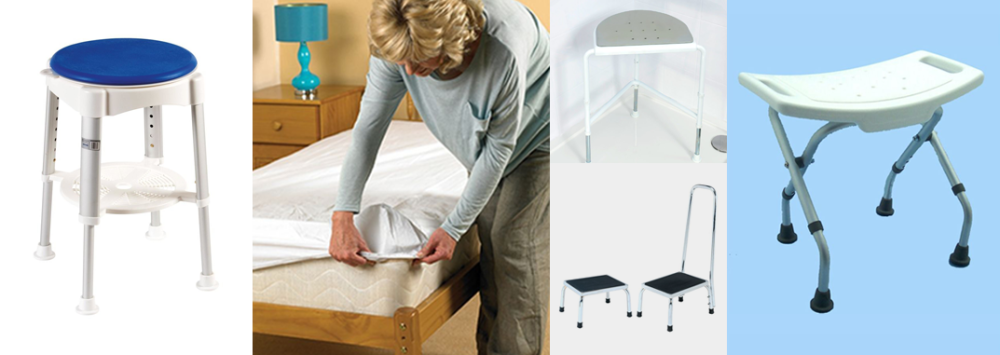
Incontinence in Later Life - Causes, Prevention and Coping
Sally Madeley-Carr, OT27 Dec 2021
Urinary incontinence is when the storage and release of urine from the bladder no longer functions as normal.
There can be many reasons for, and causes of, urinary incontinence, some leading to short-term conditions and others to long-term.
Urinary incontinence can be brought on by:
- family genes - urinary incontinence can prove to be a genetic condition, which is passed down through the family
- ageing - incontinence is common in middle age and very common in later years
- particular illnesses e.g. diabetes, stroke, multiple sclerosis (MS), Parkinson's disease and dementia
- bladder problems and bladder infections.
Different Types of Incontinence
There are different types of urinary incontinence, including urge, stress, overflow, mixed, functional and also enuresis.
- Urge Incontinence
Urge incontinence can be because of minor, as well as severe, conditions e.g. an infection as opposed to diabetes or a neurological condition.
The urgent need to pass urine could be down to the muscles in the bladder walls.
The detrusor muscles relax to allow urine to enter the bladder and then contract for its release. A change in their performance could lead to leaks and incontinence.
Going to the toilet too often is referred to as having an overactive bladder, meaning that the detrusor muscles contract too often and this can cause the need for an urgent visit to the loo.
An overactive bladder can be brought on by:
- not drinking enough liquids - strong urine can irritate the bladder walls and bring on an overactive bladder
- urinary tract infections (UTIs)
- constipation - the bladder and the rectum share some nerve endings and, if the rectum becomes slightly enlarged because of constipation, the bladder will have less room to expand and will need to empty more often
- drinking too much caffeine (tea, coffee and fizzy drinks) and alcohol
- neurological conditions e.g. Parkinson's disease, multiple sclerosis and epilepsy.
- Stress Incontinence
Stress incontinence happens when the pressure inside the bladder is too much for the bladder to handle and the tube through which urine passes (the urethra) isn't strong enough to stay closed.
Physical exertion can sometimes increase pressure on the abdomen which, in turn, puts pressure on the bladder.
Laughing or sneezing can prove too much for the bladder and small leakages might occur.
The ring of muscle (the urethral sphincter) which keeps the urethra closed may become damaged e.g. through pregnancy or obesity, both of which would place added pressure on the bladder.
Neurological conditions, such as multiple sclerosis and Parkinson's disease, can bring on incontinence.
Surgery near the bladder e.g. a hysterectomy (removal of the womb) or prostate gland removal can affect the bladder.
Certain medications can cause stress incontinence.
Lung conditions can also bring on stress incontinence, as the coughing may weaken muscle strength e.g. emphysema and cystic fibrosis.
- Overflow Incontinence
Overflow incontinence is caused by a bladder obstruction or blockage, sometimes making it impossible to empty a full bladder.
Also referred to as chronic urinary retention, this condition can be because the bladder doesn't empty completely and the consequent build up of urine may lead to frequent leaks. The bladder becomes full but the individual doesn't feel any need to urinate.
Blockages could be caused by constipation, bladder stones, or an enlarged prostate gland, all placing pressure on the nearby bladder.
The bladder can also become stretched if the detrusor muscles are not fully effective, maybe because of surgery near the bladder.
The individual needs to go to the toilet quite often but finds it difficult to start to urinate and to completely empty the bladder.
Certain medications could also bring on overflow incontinence.
- Mixed Incontinence
Mixed incontinence is a mix of stress and overactive incontinence.
Women with incontinence may have both urge and stress conditions.
Mixed incontinence may also occur in men who have had prostate operations and will also affect older people.
- Functional (sometimes called 'environmental') Incontinence
Functional incontinence is when the individual has difficulty getting to the toilet in time
This may affect people who have walking difficulties and also people with mental confusion e.g. dementia. This could be just a small leak, or a full emptying of the bladder.
- Enuresis
Enuresis is the involuntary passing of urine from an adult who can normally control their bladder.
Enuresis can happen during the day (diurnal) or during the night (nocturnal).
As many as one in every one hundred people may be affected by wetting the bed, or wetting oneself during the day. This can occur because of:
- a genetic link to enuresis
- smaller functional bladder capacity (FBC)
- an unstable or overactive bladder (OAB), caused by faulty detrusor muscles.
Illness, medication and dementia can make the individual less aware that they need to urinate.
Visit a Doctor
The individual who begins to experience urinary incontinence should visit their GP, as this condition can affect normal life. The individual may:
- feel a negative impact on their quality of life
- lead to falls, as the individual rushes to the toilet
- bring about a reduction in social activities
- point to some underlying condition and one which could be managed by medical intervention
- point to some more serious health condition, which may benefit from early intervention.
How to Manage Urinary Incontinence
There are certain steps which may prevent urinary incontinence becoming an issue and these include:
- reducing or avoiding alcohol, as well as reducing caffeine, as these can encourage the kidneys to make more urine
- keeping your pelvic floor muscles strong - pregnancy can weaken pelvic floor muscles but everyone will benefit from strengthening these important muscles
- controlling your weight - exercise regularly and eat healthily.
If urinary incontinence isn't addressed, it can lead to anxiety, depression, loss of interest in sex and sleep loss.
Coping with Urinary Incontinence in Everyday Life
There are several ways to protect oneself and stay dry, with many different types of both washable and disposable incontinence products to choose from. Pads for men and women may differ, with the bottom part of the product being the main point of absorbency for women and the front part being more appropriate for men.
Choosing the right product for you will also depend on your lifestyle:
- are you an active person
- do you spend a lot of time out of the house
- what are your normal day-to-day activities
- what style of clothing do you wear?
- Disposable pads for men
Male pads are designed to be worn inside close-fitting underwear.
With elastic edging, they fit snugly around the penis and scrotum.
Disposable pads are intended for light leakage and for use during the active part of the day. These pads are held in place by an adhesive strip.
More absorbent pads will be more bulky.
Whilst one design or brand may not feel right for you, try other brands before thinking of trying different methods.
- Washable pads for men
Washable pads are useful during the day for mild leakage and for those who might have a small urine loss after urinating.
Washable pads do not have adhesive fasteners and need to be held in place by close-fitting underwear.
Like babies' nappies, the pads have a hydrophobic layer, which draws urine away from the skin and into the pad.
- Washable incontinence pants for men
Washable incontinence pants look like normal pants but have a built in absorbent layer. They come in Y front, brief and boxer designs.
- Disposable pads for women
Some pads are rectangular and others are designed to give a more personal fit, with elastic edges, forming them into a cupped shape and helping them retain more urine.
- Washable pads for women
Worn inside closely fitting pants, the hydrophobic layer draws urine away from the skin and into the pad.
- Washable incontinence pants for women
Washable incontinence pants for women are comfortable, discrete and durable.
- Disposable pull-on pads and pants for both men and women
Sometimes referred to as disposable underwear, these are a combination of pants and pad.
Pull-on pants are for daytime use and not for use during sleeping hours, as the body in a horizontal position will not make use of the pads designed for daytime, upright, use.
Disposable pull-on pads and pants look like normal underwear and help the user to maintain dignity and discretion.
Comparing Disposable to Washable
Washable products cost more up front but can prove to be more convenient.
Washable products tend to be a little more bulky than disposable products, so may not prove to be as discreet.
Heavy leakage does not do so well with disposable products for people who are out and about but prove to be better suited to use at home.
Incontinence Mattress Protectors
Incontinence mattress protectors are designed to protect your mattress and bed from dampness, odours and stains from urinary and faecal incontinence.
Incontinence mattress protectors can encase the whole mattress, or can be disposable or washable mattress slips which are held in place over the mattress with adhesive strips, keeping them in place over the area most likely to be affected.
Using both an incontinence mattress protector and an incontinence mattress slip will both keep the bed dry and allow you to change the incontinence mattress slip as an when necessary. This will greatly reduce the effort needed during night time changes and will help maintain mattress life.
Disposable and washable incontinence slips can also be used to give protection to seats and wheelchairs.
Summary
When choosing the right incontinence protection for you, you need to consider your lifestyle and what will prove most effective and discreet for you. Remember that larger pads are more noticeable and even in the bathroom reduces the mobility issue using the bath stool.
Decide which style of protection allows you the most independence.
Drying washable products can prove quite expensive.
Teaming an incontinence mattress protector with an incontinence mattress slip will save on time and reduce inconvenience during night time changes.

Sally Madeley-Carr, OT
Sally qualified as an Occupational Therapist in 1996 and is a well-respected professional in the field of rehabilitation equipment and living aids. She has worked in private practice and within the NHS, developing a broad experience with adults and children. Click here for Sally's registration with the Health and Care Professions Council. The HCPC regulates health, psychological and social work professionals in the UK.